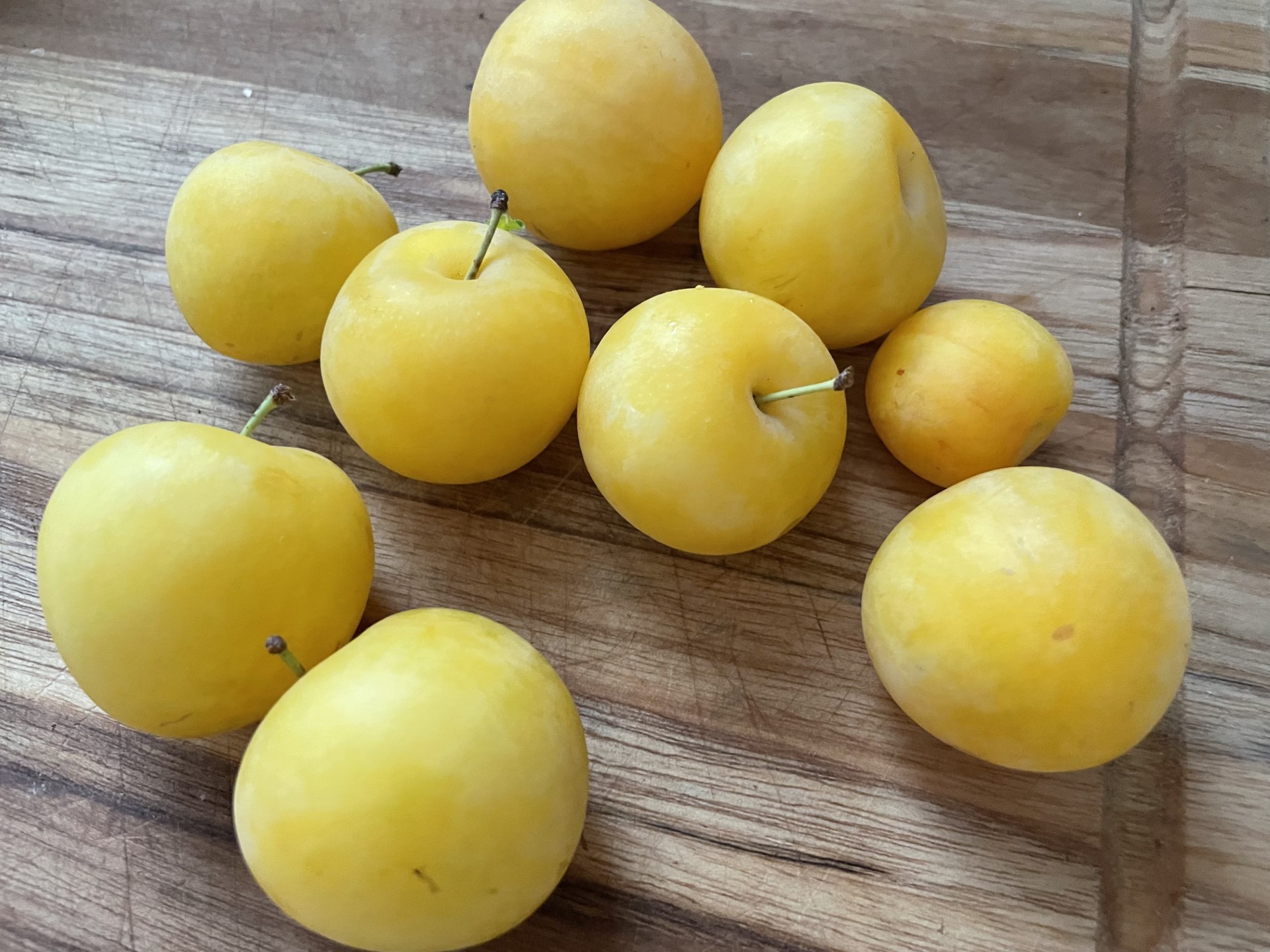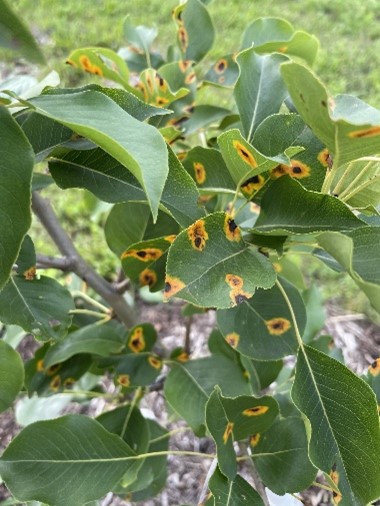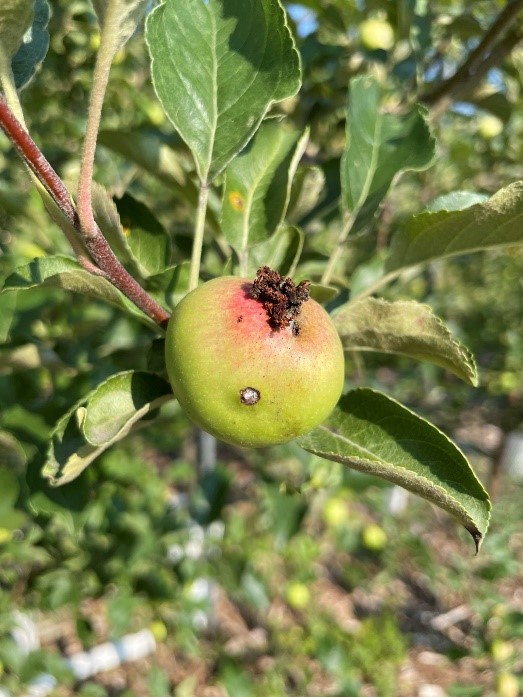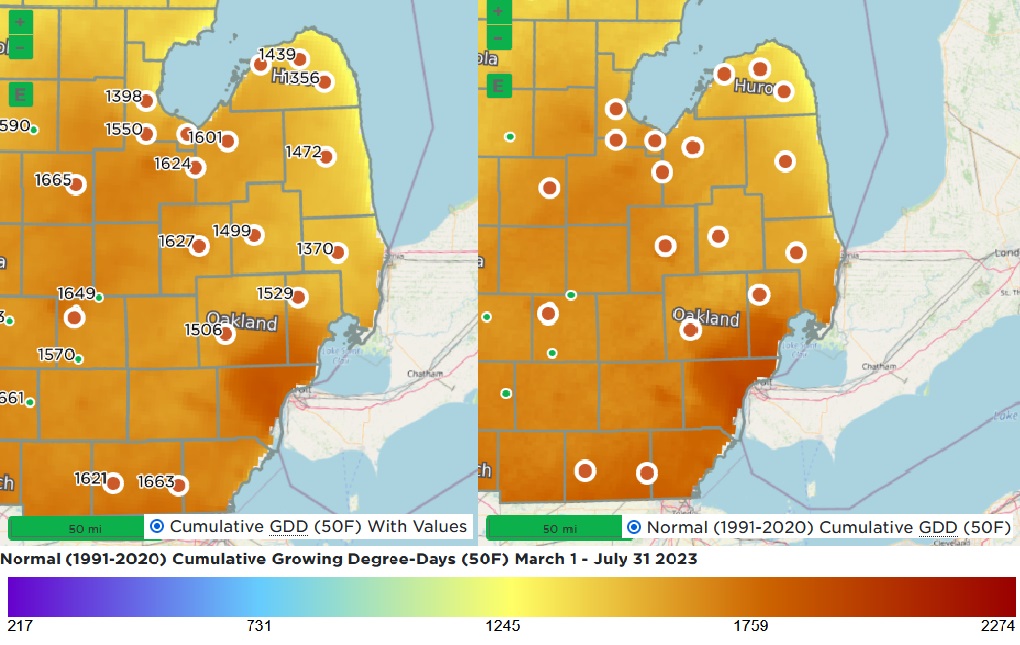Southeast Michigan fruit update - August 1, 2023
Growers are continuing harvests and preparing for brown marmorated stink bug. Spotted wing Drosophila has been caught in the region.

Welcome to the 16th in-season fruit article update for southeast Michigan for the 2023 season. Throughout the season these updates will include information about the weather in the past week and the upcoming week, a fruit-by-fruit guide to current conditions with appropriate pest and disease updates, and other relevant observations.
General observations
This week’s update covers the last two weeks. The last two week brought some regular rainfall, about 2 inches total, which helps to provide relief from the dryness from earlier in the season. Despite that our region remains in a state of “abnormally dry” conditions according to the U.S. Drought Monitor. We expect some more rain later in the week on Thursday and Sunday into Monday.
Growers are moving through peach harvest, with Redhaven expected to be ready to pick this week. Blueberry and some raspberry u-picks remain open and growers with blackberries have started direct sales.
Based on the RimPro models at the Romeo station, for which you can see you an overview by following the link, we will see continued risk for apple powdery mildew. We are past primary scab season, but with rain comes the risk of secondary scab infections. There is also risk this week for grape powdery mildew.
Apple maggot, brown marmorated stink bug, and spotted wing Drosophila have been caught in the region. Spotted wing Drosophila infestations can still be present when catches are low and the damage from spotted wing Drosophila can be extensive enough that for many growers it makes sense to treat susceptible crops even if there are low counts in traps. Here is a collection of spotted wing Drosophila factsheets that Michigan State University Extension has put out. We are starting to see brown marmorated stink bug, which can be a particular problem in peaches and apples. A good way to prepare for it this season is to read this management factsheet for brown marmorated stink bug in Michigan.
Our Southern Michigan Fruit IPM weekly meetings wrapped up at the end of June. The back catalog of the weekly fruit meetings for southern Michigan can be seen on MSU’s Kaltura Media Space.
Fruit-by-fruit conditions
Apples: Yellow Transparents and Lodis are being harvested in the region. King fruit observed in Britton were up to 70 millimeters. Apple maggot has been caught in the region as well as codling moth second flight. Brown marmorated stink bug populations are climbing.
Blueberries: U-pick blueberry harvest continues. If possible, with your pre-harvest intervals continue to protect against spotted wing Drosophila.
Brambles: Some summer red raspberry patches have ended harvest and been mowed down, though harvest continues in other places. Blackberries are being harvested in Lenawee County. Growers should continue to protect plants from anthracnose and spur blights.
Cherries: Most sweet cherries are harvested. Tart cherry harvest continues at some locations but is mostly done for the season.
Grapes: We are seeing berry touch in tight-clustered cultivars in Fenton and Ray Township color change in some varieties, like Reliance. Some growers have set large crops that may need thinning or cluster removal, which can be done midsummer.
Strawberries: Most growers have wrapped up harvest. Renovation should start as soon as harvest is finished.
Peaches and nectarines: Most growers are harvesting early cultivars. Redhaven is expected to be ready this week.
Pears: European pear fruitlets continue to grow. Asian pears in Macomb Township were observed up to 40 millimeters.
Plums: Golden plums are being harvested.

Disease conditions

Apple black rot has been seen in the region. Fruits with this condition will often ripen well ahead of healthy fruit and can be a source of spores to infect other fruit. These fruits should be removed from the orchard.
Apple powdery mildew has been seen in the region. The RimPro model indicates we are entering another period of high infection risk. Here is a link for a 2010 article on what to do with current apple powdery mildew infection. As always with older articles, cross check the recommendations for chemicals with the current E-154 guide.
Apple scab has been reported in the region in susceptible cultivars and locations. We are past the primary scab infection window. If scab is present in your orchard, you may need to spray to prevent secondary infections.
Fire blight strikes have been seen in the region, especially in areas with recurring infections and areas that experienced physical damage. For shoot blight, strikes should be pruned out with cuts 12-18 inches below visible damage and instruments should be sanitized between cuts. Here is some practical management information from Washington State Extension.
Pear rust is primarily controlled by separation of juniper species from pear plantings (much like cedar apple rust). Symptoms appear on pears in summer, but most control needs to happen early in the season when galls appear on junipers (around May).
Peach rusty spot has been seen in the region.
Scouts are seeing sooty blotch in the centers of trees with large canopies, but not in high-density orchards with good spray penetration.
Insect conditions
In tree fruit, we are at the point of controlling summer pests like spotted wing Drosophila, brown marmorated stink bug, and apple maggot. The E-154 guide can be purchased here: https://shop.msu.edu/products/bulletin-e0154.
Apple maggot: Scouts have seen these around the region. Areas that usually have high pressure are seeing high counts, but numbers are lower than last week with 1 to 5 maggots being found on most traps.
Brown marmorated stink bug: We continue to see small numbers of brown marmorated stink bug, which is expected to climb as we get closer to harvest. Early control is key here because they will continue to be a pest up until harvest when sprays are not possible because of pre-harvest intervals.
Codling moth: Areas with high pressure are seeing regular numbers. The second flight continues and in conventionally managed sites the numbers seem to be climbing. Since we are behind on growing degree days, we are not likely to see a third generation this year.

Grape berry moth: We are in the middle of the second generation. Second and third generation control are most effective at reducing infestations during harvest.
Mites: Populations of European red mite and twospotted spider mite have been relatively low for this time of year and there hasn’t been much leaf bronzing reported. John Wise recently update an article on mite management in hot and dry conditions.
Obliquebanded leafroller: To be prepared for action, read this recent article on obliquebanded leafroller control by Julianna Wilson and John Wise.
Oriental fruit moth: Catches were higher in the last two weeks, mostly in the teens to low 20s in each trap.
Phylloxera: Galls mostly being seen in susceptible cultivars near woodlines with wild grapes.
Spotted wing Drosophila: Scouts in southeast Michigan caught some SWD in grapes and raspberries. Numbers are low, with 2 to 3 catches in traps each week. SWD infestations can still be present when catches are low and the damage from SWD can be extensive enough that for many growers it makes sense to treat susceptible crops even if there are low counts in traps. Familiarize yourself with information on our spotted wing Drosophila factsheets page.
Woolly apple aphid: These have been heavy in some places even after control, particularly in orchards with larger canopy trees.
Seasonal weather update
There will be a chance of showers on Thursday and Sunday into Monday. Overall temperatures will be cooler with topping out around 80 degrees Fahrenheit. Low temperatures may even drop into the high 50s F.
Despite more consistent precipitation, the region remains in a state of “abnormally dry” conditions according to the U.S. Drought Monitor. MSU Extension has a collection of articles related to drought on its drought resources page.
| Liquid Precipitation Accumulation Mar. 1 - August 1, 2023, issued August 1, 2023 | ||||
| Station (County) | Rainfall Total (in.) Current | Hours with Rainfall Current | Rainfall Total Average (5 Yr.) | Hours with Rainfall Average (5 Yr.) |
| Commerce (Oakland) | 15.3 | 274 | 14.4 | 245 |
| Deerfield (Monroe) | 13.8 | 230 | 14.5 | 244 |
| East Lansing MSU Hort (Ingham) | 14.6 | 241 | 14.0 | 237 |
| Emmett (St. Clair) | 18.8 | 293 | 12.3 | 260 |
| Flint (Genesee) | 15.6 | 245 | 13.2 | 241 |
| Freeland (Saginaw) | . | . | . | . |
| Hudson (Lenawee) | 14.5 | 270 | 15.2 | 260 |
| Ithaca (Gratiot) | 14.2 | 203 | 13.7 | 222 |
| Lapeer (Lapeer) | 15.8 | 203 | 12.7 | 238 |
| Linwood (Bay) | 13.7 | 221 | 13.2 | 230 |
| Pigeon (Huron) | 13.7 | 235 | 10.9 | 215 |
| Richville/Frankenmuth (Tuscola) | 13.6 | 214 | 12.9 | 213 |
| Sandusky (Sanilac) | 14.5 | 271 | 11.9 | 205 |
| Romeo (Macomb) | 17.5 | 270 | 13.6 | 224 |
| Average of stations in this region: | 15.0 | 243.8 | 13.3 | 233.5 |
| Difference in Liquid Precipitation Accumulation from Mar. 1 observed July 18 and August 1, 2023; issued August 1, 2023 | ||||||
| Station (County) | Rainfall Total (in.) July 18 | Rainfall Total (in.) August 1 | Difference from July 18-August 1 | Hours with Rainfall July 11 | Hours with Rainfall August 1 | Difference from July 18-August 1 |
| Commerce (Oakland) | 13.2 | 15.3 | 2.2 | 253 | 274 | 21.0 |
| Deerfield (Monroe) | 10.9 | 13.8 | 2.9 | 215 | 230 | 15.0 |
| East Lansing MSU Hort (Ingham) | 13.1 | 14.6 | 1.5 | 222 | 241 | 19.0 |
| Emmett (St. Clair) | 17.2 | 18.8 | 1.6 | 269 | 293 | 24.0 |
| Flint (Genesee) | 14.0 | 15.6 | 1.5 | 228 | 245 | 17.0 |
| Freeland (Saginaw) | . | . | . | . | . | . |
| Hudson (Lenawee) | 11.1 | 14.5 | 3.4 | 212 | 270 | 58.0 |
| Ithaca (Gratiot) | 11.4 | 14.2 | 2.8 | 193 | 203 | 10.0 |
| Lapeer (Lapeer) | 13.2 | 15.8 | 2.6 | 187 | 203 | 16.0 |
| Linwood (Bay) | 12.8 | 13.7 | 0.8 | 210 | 221 | 11.0 |
| Pigeon (Huron) | 12.9 | 13.7 | 0.8 | 221 | 235 | 14.0 |
| Richville/Frankenmuth (Tuscola) | 11.5 | 13.6 | 2.1 | 198 | 214 | 16.0 |
| Sandusky (Sanilac) | 13.3 | 14.5 | 1.2 | 243 | 271 | 28.0 |
| Romeo (Macomb) | 14.8 | 17.5 | 2.7 | 253 | 270 | 17.0 |
| Average of stations in this region: | 13.0 | 15.0 | 2.0 | 223.4 | 243.8 | 20.5 |
The medium range guidance calls for normal to cooler than normal temperatures with near normal precipitation in the next couple weeks .
Our regional average growing degree day accumulation has fallen behind the 5-year average by a few days.
Read this Michigan State University Extension article to learn more about degree days: Understanding growing degree-days.

| Degree Day Accumulation Mar. 1 -August 1, 2023, Forecast from August 2-7, 2023; issued August 1, 2023 | |||||||||
| Station (County) | Degree Days Base 42 F Current | Degree Days Base 42 F Average (5 Yr.) | Degree Days Base 42 F Forecast | Degree Days Base 45 F Current | Degree Days Base 45 F Average (5 Yr.) | Degree Days Base 45 F Forecast | Degree Days Base 50 F Current | Degree Days Base 50 F Average (5 Yr.) | Degree Days Base 50 F Forecast |
| Commerce (Oakland) | 2301 | 2469 | 2486 | 1975 | 2142 | 2141 | 1484 | 1641 | 1621 |
| Deerfield (Monroe) | 2489 | 2683 | 2673 | 2148 | 2339 | 2314 | 1633 | 1814 | 1770 |
| East Lansing MSU Hort (Ingham) | 2447 | 2519 | 2628 | 2110 | 2188 | 2274 | 1603 | 1679 | 1737 |
| Emmett (St. Clair) | 2162 | 2348 | 2336 | 1839 | 2028 | 1996 | 1357 | 1541 | 1483 |
| Flint (Genesee) | 2481 | 2619 | 2664 | 2144 | 2285 | 2309 | 1636 | 1770 | 1771 |
| Freeland (Saginaw) | 2324 | 2442 | 2500 | 1998 | 2120 | 2156 | 1508 | 1625 | 1636 |
| Hudson (Lenawee) | 2398 | 2543 | 2579 | 2066 | 2211 | 2229 | 1568 | 1703 | 1701 |
| Ithaca (Gratiot) | 2491 | 2517 | 2674 | 2158 | 2191 | 2324 | 1650 | 1688 | 1785 |
| Lapeer (Lapeer) | 2278 | 2425 | 2455 | 1953 | 2100 | 2112 | 1468 | 1605 | 1597 |
| Linwood (Bay) | 2186 | 2322 | 2360 | 1865 | 2005 | 2022 | 1387 | 1522 | 1513 |
| Pigeon (Huron) | 2232 | 2295 | 2411 | 1914 | 1983 | 2074 | 1433 | 1508 | 1563 |
| Richville/Frankenmuth (Tuscola) | 2443 | 2508 | 2619 | 2110 | 2182 | 2268 | 1606 | 1679 | 1734 |
| Sandusky (Sanilac) | 2253 | 2331 | 2428 | 1932 | 2018 | 2089 | 1446 | 1538 | 1574 |
| Romeo (Macomb) | 2350 | 2532 | 2530 | 2020 | 2202 | 2182 | 1517 | 1696 | 1648 |
| Average of stations in this region: | 2345 | 2468 | 2525 | 2017 | 2142 | 2178 | 1521 | 1644 | 1652 |
| Difference in Degree Day Accumulation from Mar. 1 observed July 18, and August 1, 2023; issued August 1, 2023 | |||||||||
| Station (County) | Degree Days Base 42 F July 18 | Degree Days Base 42 F August 1 | Degree Days Base 42 F Difference | Degree Days Base 45 F July 18 | Degree Days Base 45 F August 1 | Degree Days Base 45 F Difference | Degree Days Base 50 F July 18 | Degree Days Base 50 F August 1 | Degree Days Base 50 F Difference |
| Commerce (Oakland) | 1913 | 2301 | 388.0 | 1628 | 1975 | 347.0 | 1208 | 1484 | 276.0 |
| Deerfield (Monroe) | 2083 | 2489 | 406.0 | 1784 | 2148 | 364.0 | 1340 | 1633 | 293.0 |
| East Lansing MSU Hort (Ingham) | 2012 | 2447 | 435.0 | 1723 | 2110 | 387.0 | 1296 | 1603 | 307.0 |
| Emmett (St. Clair) | 1788 | 2162 | 374.0 | 1508 | 1839 | 331.0 | 1095 | 1357 | 262.0 |
| Flint (Genesee) | 2066 | 2481 | 415.0 | 1771 | 2144 | 373.0 | 1333 | 1636 | 303.0 |
| Freeland (Saginaw) | 1924 | 2324 | 400.0 | 1639 | 1998 | 359.0 | 1219 | 1508 | 289.0 |
| Hudson (Lenawee) | 2007 | 2398 | 391.0 | 1717 | 2066 | 349.0 | 1289 | 1568 | 279.0 |
| Ithaca (Gratiot) | 2085 | 2491 | 406.0 | 1794 | 2158 | 364.0 | 1356 | 1650 | 294.0 |
| Lapeer (Lapeer) | 1894 | 2278 | 384.0 | 1611 | 1953 | 342.0 | 1196 | 1468 | 272.0 |
| Linwood (Bay) | 1807 | 2186 | 379.0 | 1529 | 1865 | 336.0 | 1120 | 1387 | 267.0 |
| Pigeon (Huron) | 1840 | 2232 | 392.0 | 1563 | 1914 | 351.0 | 1153 | 1433 | 280.0 |
| Richville/Frankenmuth (Tuscola) | 2045 | 2443 | 398.0 | 1753 | 2110 | 357.0 | 1319 | 1606 | 287.0 |
| Sandusky (Sanilac) | 1854 | 2253 | 399.0 | 1575 | 1932 | 357.0 | 1160 | 1446 | 286.0 |
| Romeo (Macomb) | 1952 | 2350 | 398.0 | 1663 | 2020 | 357.0 | 1230 | 1517 | 287.0 |
| Average of stations in this region: | 1948 | 2345 | 398 | 1661 | 2017 | 355 | 1237 | 1521 | 284 |
Watch Jeff Andresen's weekly agricultural weather forecast reports.
More information and reports on normal weather conditions and departures from normal can be found on the NOAA Climate Prediction Center website, NOAA U.S. Climate Normals website, NOAA Climate Normals Quick Access Page (which may be searched by region), and Midwest Regional Climate Center website.



 Print
Print Email
Email




